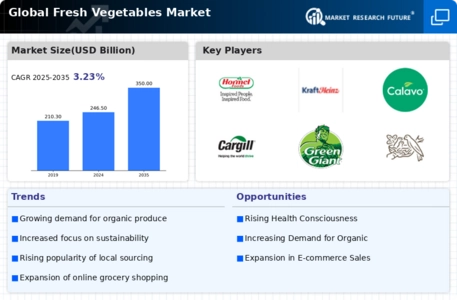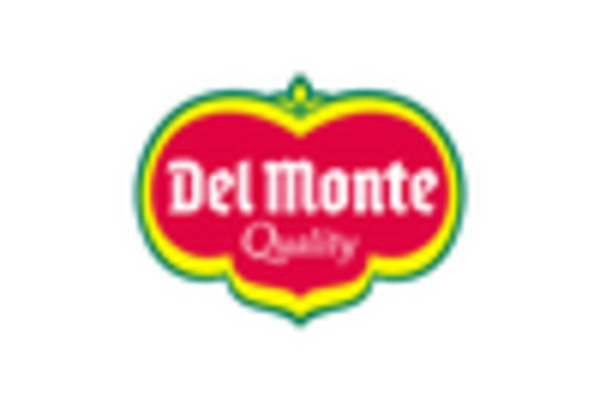Rising Health Awareness
The increasing awareness regarding health and nutrition among consumers appears to be a pivotal driver for The Global Fresh Vegetables Industry. As individuals become more conscious of their dietary choices, the demand for fresh vegetables is likely to surge. Reports indicate that the consumption of fresh vegetables has risen by approximately 20 percent over the past five years, reflecting a shift towards healthier eating habits. This trend is further supported by various health organizations advocating for a diet rich in vegetables, which is perceived as essential for preventing chronic diseases. Consequently, The Global Fresh Vegetables Industry is experiencing a transformation, with consumers prioritizing fresh produce over processed foods, thereby enhancing market growth.
Sustainability and Organic Farming
Sustainability initiatives are increasingly influencing consumer preferences, thereby driving The Global Fresh Vegetables Industry. The shift towards organic farming practices is notable, as consumers express a preference for sustainably sourced products. Data suggests that organic vegetable sales have grown by over 30 percent in recent years, indicating a robust market for organic produce. This trend is not merely a passing phase; it reflects a broader societal commitment to environmental stewardship and sustainable agriculture. As more farmers adopt eco-friendly practices, The Global Fresh Vegetables Industry is likely to benefit from a growing segment of environmentally conscious consumers who are willing to pay a premium for organic and sustainably grown vegetables.
Urbanization and Changing Lifestyles
Urbanization is a significant factor influencing The Global Fresh Vegetables Industry. As more people migrate to urban areas, the demand for fresh vegetables is likely to increase due to changing lifestyles and dietary preferences. Urban consumers often seek convenience and quality, leading to a rise in the consumption of fresh produce. Market data indicates that urban areas account for over 70 percent of vegetable consumption, highlighting the importance of this demographic. Additionally, the trend towards meal kits and ready-to-eat fresh vegetable options is gaining traction in urban settings. This shift is expected to further propel The Global Fresh Vegetables Industry, as suppliers adapt to meet the needs of urban consumers.
Global Trade and Export Opportunities
The expansion of The Global Fresh Vegetables Industry. As countries seek to diversify their agricultural exports, fresh vegetables are becoming a key component of international trade. Data shows that exports of fresh vegetables have increased by approximately 15 percent in the last year, driven by demand from emerging markets. This trend is likely to continue as countries invest in improving their agricultural infrastructure and logistics. Furthermore, trade agreements and partnerships are facilitating easier access to international markets, allowing producers to reach a broader consumer base. As a result, The Global Fresh Vegetables Industry is poised for growth, benefiting from enhanced export opportunities and increased global demand.
Technological Advancements in Agriculture
Technological advancements in agriculture are reshaping the landscape of The Global Fresh Vegetables Industry. Innovations such as precision farming, hydroponics, and vertical farming are enhancing productivity and efficiency in vegetable production. These technologies enable farmers to optimize resource use, reduce waste, and increase yield per acre. For instance, hydroponic systems can produce vegetables with up to 90 percent less water than traditional farming methods. As these technologies become more accessible, they are expected to drive down costs and improve the quality of fresh vegetables available in the market. Consequently, The Global Fresh Vegetables Industry stands to gain from increased supply and improved product offerings, catering to the evolving demands of consumers.


















Leave a Comment